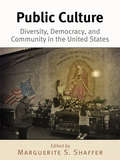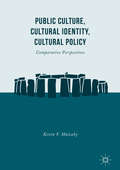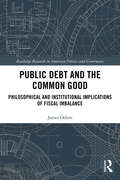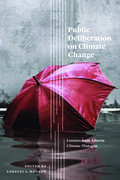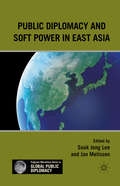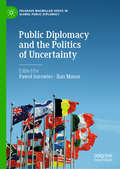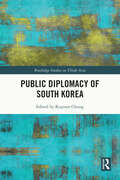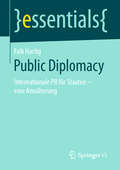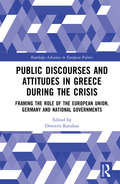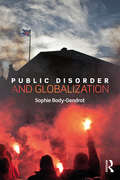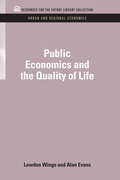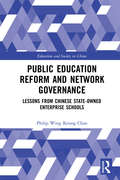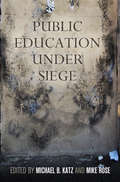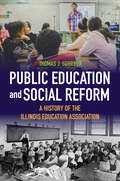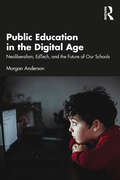- Table View
- List View
Public Culture
by Marguerite S. ShafferIn the United States today many people are as likely to identify themselves by their ethnicity or region as by their nationality. In this country with its diversity and inequalities, can there be a shared public culture? Is there an unbridgeable gap between cultural variety and civic unity, or can public forms of expression provide an opportunity for Americans to come together as a people?In Public Culture: Diversity, Democracy, and Community in the United States, an interdisciplinary group of scholars addresses these questions while considering the state of American public culture over the past one hundred years. From medicine shows to the Internet, from the Los Angeles Plaza to the Las Vegas Strip, from the commemoration of the Oklahoma City bombing to television programming after 9/11, public sights and scenes provide ways to negotiate new forms of belonging in a diverse, postmodern community. By analyzing these cultural phenomena, the essays in this volume reveal how mass media, consumerism, increased privatization of space, and growing political polarization have transformed public culture and the very notion of the American public.Focusing on four central themes--public action, public image, public space, and public identity--and approaching shared culture from a range of disciplines--including mass communication, history, sociology, urban studies, ethnic studies, and cultural studies--Public Culture offers refreshing perspectives on a subject of perennial significance.
Public Culture, Cultural Identity, Cultural Policy
by Kevin V. MulcahyThis book places the study of public support for the arts and culture within the prism of public policy making. It is explicitly comparative in casting cultural policy within a broad sociopolitical and historical framework. Given the complexity of national communities, there has been an absence of comparative analyses that would explain the wide variability in modes of cultural policy as reflections of public cultures and cultural identity. The discussion is internationally focused and interdisciplinary. Mulcahy contextualizes a wide variety of cultural policies and their relation to politics and identity by asking a basic question: who gets their heritage valorized and by whom is this done? The fundamental assumption is that culture is at the heart of public policy as it defines national identity and personal value.
Public Debt and the Common Good: Philosophical and Institutional Implications of Fiscal Imbalance (Routledge Research in American Politics and Governance)
by James OdomThe American national debt stands at $20.49 trillion as of January 2018, or roughly $63,000 for every person in the United States. The national debt has grown six-fold in the past 25 years, and borrowing only has accelerated in recent administrations. What are the factors driving such unrestrained borrowing? Is American fiscal policy different now than in an earlier era? Is there a moral dimension to public debt and, if so, how can that dimension be measured? Public Debt and the Common Good addresses these and other questions by looking to the fiscal policy of the American states. Drawing on classical themes and the longest quantitative review of state debt in the literature, James Odom expertly integrates institutional analysis with dimensions of culture to define the parameters of political freedom in a theoretically coherent way. In doing so, Odom argues that centralization and injustice, or the incapacity for the common good, can help explain state indebtedness. Contributing to ongoing scholarly debates on public debt theory, this book will be of interest to students, scholars, and practitioners who work at the intersection of political philosophy and economics, as well as those who specialize in state public policy, state politics, and federalism more generally.
Public Debt in Kenya: An Economic History (Routledge Studies in Development Economics)
by Aaron ThegeyaPublic debt in developing economies has increased dramatically over the last 20 years, with debt repayment obligations putting the livelihoods of millions of individuals at risk and threatening to stall progress toward lowering poverty rates and achieving long- term development objectives across many countries, especially in sub-Saharan Africa. Debt fragility is a systemic issue that affects many countries spanning different continents, regardless of the idiosyncratic nature of each country’s system of government and drivers of growth. Kenya is one of these fragile economies, currently classified as an economy at high risk of default.This book gives a historical economic account of public debt in Kenya, dating back to the late 1800s. It describes the key episodes and events that resulted in the accumulation of debt and gives an intuitive understanding of the economic dynamics of debt during the precolonial, colonial, and postcolonial periods in Kenya’s history. Existing studies on Kenya’s public debt are either not comprehensive, choosing to focus on a narrow period, or are technical empirical analyses, rendering them inaccessible to a large audience. By describing the dynamics of public debt in Kenya, the book increases familiarity with a topic that has important implications for Kenya, and which has occupied a central stage in Kenya’s policy debates in the recent past.History shows that contagion from economic crises is not unique and isolated to individual nations, thus the book is relevant not only for policy debates in Kenya, but also for other low- income and emerging economies within sub- Saharan Africa.
Public Deliberation on Climate Change: Lessons from Alberta Climate Dialogue
by Lorelei L. Hanson David KahaneThere exists in both academic and political circles a growing interest in public deliberation as an alternative to the sometimes adversarial and polarizing public engagement activities that result in the pitting of experts against lay people. Proponents of public deliberation claim that a more deliberative process can engage a diversity of participants in a more guided process that better balances expert knowledge and citizen inclusion. Such an approach holds particular promise where citizens and governments engage in discussions of the most complex and intractable issues like climate change. Given the host of challenges climate governance presents and the global consequences of our response to them, the experience and knowledge shared by Hanson and the contributors to Public Deliberation on Climate Change provide an important framework for advancing public conversations and processes on this and other wicked problems. The lessons contained in the volume were gained as a result of a five year multidisciplinary, community, university research project called Alberta Climate Dialogue (ABCD), which drew together scholars, practitioners, citizens, civil society members, and government officials from across Alberta at four public deliberations. By highlighting the value tensions and trade-offs and examining the impact that the design of the deliberations has on policy and the creation of conditions that encourage exchange, the contributors aim to build capacity within our institutions and society to find new ways to discuss and solve complex problems.
Public Diplomacy and Civil Society Organisations (Routledge Explorations in Development Studies)
by Ibrahim NatilThis book explores the roles of civil society organisations (CSOs) when engaging in public diplomacy activities and their impact on community development and change. It provides up-to-date analysis of the challenges and constraints facing CSOs involved in diplomatic missions and working with foreign donors. Bringing together case studies from Cameroon, Egypt, Poland, Palestine, Lebanon and Libya, this edited collection reflects on how external calls for proposals in the fields of women’s empowerment, community development, education, training, exchange programmes, democracy, human rights and peacebuilding influence the way civil society organisations contribute, deliver, intervene and position themselves in various societies. It explores the lessons learnt by various CSOs in identifying societal problems, understanding grassroots demands, prioritising development agendas and campaigning for peacebuilding. Grounded in a firm theoretical framework and based on up-to-date empirical research, the book reflects on the leadership shown by civil society organisations in development, politics and business and their impact on community development initiatives and local change process. This book will be an important resource for researchers, policymakers, donors, NGO practitioners and the beneficiaries themselves, within the areas of international development, peacebuilding, civil society, politics and international relations.
Public Diplomacy and Soft Power in East Asia
by Sook Jong Lee Jan MelissenThis book discusses the question of soft power and public diplomacy challenges in East Asian context. Both concepts originate in the West, and in a sense this book can therefore be seen as an exercise in critically assessing soft power and public diplomacy in a different geographical and cultural setting.
Public Diplomacy and the Implementation of Foreign Policy in the US, Sweden and Turkey
by Efe SevinThis book presents a comprehensive framework, the six pathways of connection, which explains the impact of public diplomacy on foreign policy by studying how a public diplomacy project is designed to contribute to the achievement of a related foreign policy goal. Based on a comparative study of three important public diplomacy practitioners with distinctive challenges and approaches-the US, Sweden, and Turkey-the book shows the necessity to move beyond soft power to appreciate the role of public diplomacy in global politics. First, the author lays the theoretical foundations of the framework through a survey of scholarly works related to public diplomacy. He then further develops it by analyzing how the American, Swedish, and Turkish practitioners design and implement their public diplomacy projects. Finally, the book explains how the framework can be used to design new public diplomacy projects and measure their impact on foreign policy.
Public Diplomacy and the Implementation of Foreign Policy in the US, Sweden and Turkey (Palgrave Macmillan Series in Global Public Diplomacy)
by Efe SevinThis book presents a comprehensive framework, six pathways of connection, which explains the impact of public diplomacy on achieving foreign policy goals. The comparative study of three important public diplomacy practitioners with distinctive challenges and approaches shows the necessity to move beyond soft power to appreciate the role of public diplomacy in global politics. Through theoretical discussions and case studies, six pathways of connection is presented as a framework to design new public diplomacy projects and measure their impact on foreign policy.
Public Diplomacy and the Politics of Uncertainty (Palgrave Macmillan Series in Global Public Diplomacy)
by Ilan Manor Paweł SurowiecThis edited book explores the multi-layered relationships between public diplomacy and intensified uncertainties stemming from transnational political trends. It is the latest wave of political uncertainty that provides the background as well as yields evidence scrutinised by authors contributing to this book. The book argues that due to a state of perpetual crises, the simultaneity of diplomatic tensions and new digital modalities of power, international politics increasingly resembles a networked set of hyper-realities. Embracing multi-polar competition, superpowers such as Russia flex their muscles over their neighbours; celebrated ‘success stories’ of democratisation – Hungary, Poland and Czechia – move towards illiberal governance; old players of international politics such as Britain and America re-claim “greatness”, while other states, like China, adapt expansionist foreign policy goals. The contributors to this book consider the different ways in which transnational political trends and digitalisation breed uncertainty and shape the practice of public diplomacy.
Public Diplomacy of South Korea (Routledge Studies on Think Asia)
by Kuyoun ChungThis book introduces South Korea’s public diplomacy and identifies and evaluates the goals and corresponding areas of. It discusses implication for the foreign policy of the current Yoon Suk Yeol administration under the competitive geopolitical landscape.By establishing political diplomacy, economic diplomacy, and public diplomacy as the three pillars of its diplomacy, South Korea has endeavored to enhance its international image and credibility, deepen foreign nationals’ understanding of South Korea’s foreign policy, and expand its soft power across the international community. However, as current U.S.–China competition continues to expand to the domains of the political system and its organizing values, middle powers are struggling to hedge the risk of competition between liberalism and anti-liberalism, which closely relates to every middle power’s state identity and potential coalitions used to pursue certain value via public diplomacy. With that context, the contributions to the book examine the public diplomacy of South Korea and its achievement, the range of domains that it prioritizes, and future directions for such diplomacy amid the competition of great powers. Focusing on the Yoon Suk-Yeol administration’s foreign policy goals and how public diplomacy has been adapted to this framework under the intensifying great power competition between the U.S. and revisionist powers, the book addresses the ideological dimension in the ongoing power to explain how countries’ respective alignments could affect South Korea’s ability to conduct public diplomacy.This book is a novel contribution to the field and will be of interest to researchers in international relations, South Korean foreign policy, and Asian politics.
Public Diplomacy: The Rise Of Confucius Institutes (essentials)
by Falk HartigDiese essential führt kompakt in das Konzept der Public Diplomacy ein. Public Diplomacy wird international in Wissenschaft und Praxis umfassend debattiert und praktiziert, in Deutschland findet der Begriff bisher allerdings nur wenig Beachtung. Es erläutert die Hintergründe, skizziert Akteure, Instrumente und Zielgruppen sowie ähnliche Begriffe. Zudem wirft das essential Schlaglichter auf bisherige Forschungslücken und leitet Möglichkeiten für weitere Forschungen ab, die sowohl für Wissenschaft und Praxis relevant sind.
Public Disclosure and Bank Failures
by Eduardo Levy Yeyati Tito CordellaA report from the International Monetary Fund.
Public Discourses About Homosexuality and Religion in Europe and Beyond
by Marco Derks Mariecke van den BergThis volume addresses three things many people do not discuss candidly with strangers or mere acquaintances: God, sex, and politics. These can easily become topics of fierce debate, particularly when taken together, as has been the case with same-sex marriage legislation, the Vatican’s criticism of “gender ideology,” or the repeatedly asserted claim that Islam, homosexuality, and gender equality are essentially incompatible. This volume investigates what is at stake in these constructions of religion and homosexuality in public discourses. Starting with the Netherlands as a special case study, it proceeds with contributions on other predominantly postsecular countries in central, northern, and southern Europe as well as several postcommunist and postcolonial countries “beyond Europe.” Combining contemporary and historical perspectives and approaches from both the humanities and the social sciences, the contributors explore how national and European identities are constructed and contested in debates on religion and homosexuality.Chapter 2 and Chapter 8 of this book are available open access under a CC BY 4.0 license at link.springer.com.
Public Discourses and Attitudes in Greece during the Crisis: Framing the Role of the European Union, Germany and National Governments (Routledge Advances in European Politics)
by Dimitris KatsikasThis book presents the findings of new empirical research regarding shifts in public discourses and attitudes in Greek society as a result of the crisis. These findings have shown different shades of Euroscepticism and anti-German sentiments, but they have also revealed a normative conflict within Greek society itself. The book shows how economic crises and strict policy conditionality, causing or deepening economic recession in the countries receiving it, has the potential to set in motion a fragmentation process, which transcends standard material stratification and relates to broader political and even cultural rifts among the population. With this, the book serves as a case study of the impact of wider pressures and shifts weighing upon the European Union (EU) and the way European societies perceive the integration process. This text will be of key interest to scholars and students of EU politics, Greek and Southern European studies and more broadly to cultural and comparative politics and political economy and European politics.
Public Discourses of Contemporary China
by Yipeng ShenExploring contemporary Chinese literature, film, and television, Yipeng Shen sheds light on the historical significance of nationalism for mass imagination and identification in the less-than-democratic system of China for the past three decades. Analyzing cultural products from a wide range of media, chapters move from the intellectual idealism of the 1980s, through the post-Tiananmen transition, to the national cinema of the 1990s, and finally to the Internet literature of today. Public Discourses of Contemporary China argues that Chinese subjects have, to varying degrees, transformed the state project of modernization into their own through mass aestheticization of the nation.
Public Disorder and Globalization
by Sophie Body-GendrotThe current growth of incidents of public disorder around the world can be seen as symptomatic of major transformations in globalized society, government, and technology. But while disorder is routinely perceived as a disturbing phenomenon, it can also be a catalyst for positive transformation and regeneration. As social media is increasingly used as a platform for mobilization and organization, local disorder may spread outward through national borders, receiving international coverage and visibility as well as triggering a domino effect of global unrest. Combining qualitative and quantitative research, this ground-breaking text analyzes oppositional notions of order and disorder in global, national, and local contexts and considers the role of the police, the justice system, and other authorities in developing a range of responsive strategies. The author develops a new comprehensive framework for engaging in comparative and historical analysis of public disorder by drawing upon international case studies of public unrest such as 2005 in Paris and 2011 in London; the events in Ferguson and Baltimore that seeded Black Lives Matter; the Occupy movements in Zuccotti Park, Gezi Park, and Hong Kong; and the terror attacks in Paris and Brussels. This dynamic comparative study is informed by extensive international interviews and will be a required reading for students and scholars of criminology, sociology, political science, and urban studies.
Public Economics
by Gareth D. MylesThis textbook provides a thorough treatment of all the central topics in public economics. Aimed at senior undergraduate and graduate students, it will also be invaluable to professional economists and to those teaching in the field. The book is entirely self-contained, giving all the equilibrium theory and welfare economics needed to understand the analyses. The author covers the Arrow-Debreu economy, welfare economics and the measurement of inequality and poverty which lay the foundations and emphasise the important role played by information. Within the competitive economy, he examines commodity taxation, income taxation and tax reform in a certain environment. He goes on to study the public economics of uncertainty, and then treats public goods, externalities, imperfect competition and tax evasion as departures from the standard competitive assumptions and looks at their implication for public economics derived.
Public Economics and the Quality of Life (RFF Urban and Regional Economics Set)
by Alan Evans Lowdon Wingo Jr.This book argues that, if redistribution was the dominant political theme of the 1960s, that of the 1970s would have been most assuredly quality. Furthermore, this seeks to poorly articulated normative concerns of physical and environmental planners to the intellectual tools, old and new, with which economists were addressing policy issues. This will be of particular interest among practitioners and theoreticians identified with the policy sciences.
Public Economics: A Concise Introduction
by José Luis Gómez-BarrosoPublic Economics: A Concise Introduction provides a concise and non-technical overview of the role of government in the economy. Using the questions ‘why?’, ‘what for?’ and ‘how?’, the text initially surveys the place of the public sector in a market economy. It then considers the possible reasons which could justify government involvement. Next, the book examines the aims of state economic activity, and the instruments which a government has at its disposal. Lastly, the final chapter provides an illuminating tour of economic history and history of economic thought in relation to government economic activity. The book offers an international focus throughout, with examples taken from all over the globe. Readers are supported with a range of pedagogical features, including example boxes, chapter objectives and summaries, and end-of-chapter multiple choice and reflection questions. Public Economics: A Concise Introduction will be a valuable text for students on courses in public economics, welfare economics, public finance, public policy and related areas.
Public Education Reform and Network Governance: Lessons From Chinese State-Owned Enterprise Schools (Education and Society in China)
by Philip Wing ChanThis book is located in the field of education governance and sits amidst debates on public school reform in China. It examines how a top-down policy approach has been implemented from central government right down to the district level within the public education system in China. It shows the way networks support negotiation and bargaining at the district level which, in turn, influences the broader education policy of the central government. Using statistical data from education yearbooks, government documents analysis and interviews with main stakeholders in this policy arena, the book incorporates case studies from railway State-Owned Enterprise schools. Analysis of these indicates that the processes of formulating and implementing Chinese education policy can be characterised as a form of network governance, which coordinates actors, decision-making processes and stakeholders’ motivation to comply with collective decisions in Chinese education. Network governance acts as an effective and legitimate way of problem solving that assists policy implementation and education reform in China. By comparing two traditional modes of governance (governance through bureaucracy and the governance through markets), this book shows the network mode of governance in Chinese education is more powerful and significant, especially since the negotiated results among actors in the policy community are favourable.
Public Education Under Siege
by Mike Rose Michael B. KatzProponents of education reform are committed to the idea that all children should receive a quality education, and that all of them have a capacity to learn and grow, whatever their ethnicity or economic circumstances. But though recent years have seen numerous reform efforts, the resources available to children in different municipalities still vary enormously, and despite landmark cases of the civil rights movement and ongoing pushes to enact diverse and inclusive curricula, racial and ethnic segregation remain commonplace. Public Education Under Siege examines why public schools are in such difficult straits, why the reigning ideology of school reform is ineffective, and what can be done about it.Public Education Under Siege argues for an alternative to the test-driven, market-oriented core of the current reform agenda. Chapters from education policy experts and practitioners critically examine the overreliance on high-stakes testing, which narrows the content of education and frustrates creative teachers, and consider how to restore a more civic-centered vision of education in place of present dependence on questionable economistic models. These short, jargon-free essays cover public policy, teacher unions, economic inequality, race, language diversity, parent involvement, and leadership, collectively providing an overview of the present system and its limitations as well as a vision for the fulfillment of a democratic, egalitarian system of public education.Contributors: Joanne Barkan, Maia Cucchiara, Ansley T. Erickson, Eugene E. Garcia, Eva Gold, Jeffrey R. Henig, Tyrone C. Howard, Richard D. Kahlenberg, Harvey Kantor, Michael B. Katz, David F. Labaree, Julia C. Lamber, Robert Lowe, Deborah Meier, Pedro Noguera, Rema Reynolds, Claire Robertson-Kraft, Jean C. Robinson, Mike Rose, Janelle Scott, Elaine Simon, Paul Skilton-Sylvester, Joi A. Spencer, Heather Ann Thompson, Tina Trujillo, Pamela Barnhouse Walters, Kevin G. Welner, Sarah Woulfin.
Public Education and Social Reform: A History of the Illinois Education Association
by Thomas J. SuhrburFounded in 1853, the Illinois Education Association (IEA) and its predecessors have played a vital role in shaping the Illinois public school system. Thomas J. Suhrbur’s history covers the lifespan of the IEA within the larger story of state public education as a battleground for contentious social and economic issues. Suhrbur pays particular attention to the impact of race, gender, religion, and tax policy on the IEA and public schools. He also examines the IEA’s evolution from a professional organization controlled by administrations and officials through its radical transformation into a teacher-led independent labor union. As a workers’ organization, the IEA successfully fought for collective bargaining and organized K–12 and higher education while continually standing against right-wing efforts to privatize education and undermine public schools with vouchers, for-profit institutions, and tax credits. Multifaceted and up to date, Public Education and Social Reform tells the story of the organization and figures dedicated to sustaining and advancing Illinois public education.
Public Education in Turbulent Times: Innovative Strategies for Leadership and Learning
by Faiza M. Jamil Javaid E. SiddiqiPublic Education in Turbulent Times communicates a bold vision for the future of education, addressing the evolving purpose of American public education and the structural innovations schools are using to meet the needs of a rapidly transforming world. Highlighting key challenges that emerged during the immense economic and social disruptions of recent years, the book leverages case studies of four unique school districts where school communities overcame concerns high in the public consciousness – trauma, danger, economic inequality, and racial injustice. These obstacles have hampered efforts to reclaim lost learning opportunities that could define the educational experiences of a generation of students. If educators revert to business as usual, they risk dismissing essential lessons from resilient schools that thrived in the chaos of a global pandemic and its fallout. This book provides rich insights to refocus readers’ attention on achieving a more equitable and safe education system for the future.
Public Education in the Digital Age: Neoliberalism, EdTech, and the Future of Our Schools
by Morgan AndersonEducational technology is now ubiquitous in schooling, both in P-12 and at universities. Despite the imposition of technology in most aspects of teaching and learning, little attention has been given to the implications educational technology has for healthy student development, humane pedagogy, teacher labor, academic freedom, and the aims of social justice. Rather than merely a set of neutral tools, educational technology is bound up with systems of power and privilege that tend to deepen, rather than confront inequality. In calling for a reassessment of the relationship between schools and technology, this book asks readers to think differently about the role technology can serve in socially just schools. An accessible and compelling read, this book will appeal to students and scholars of sociology, social justice, politics, and all those interested in the impact technology is having on the education system in the USA.
